


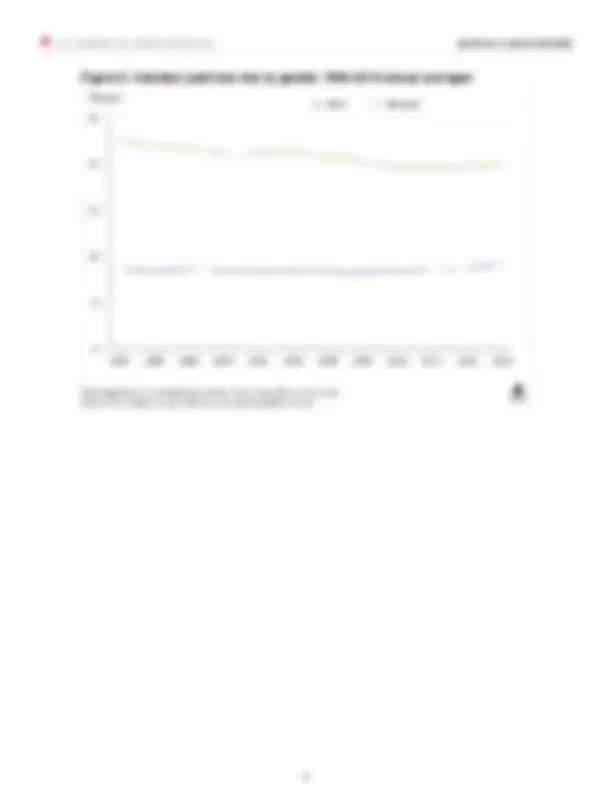
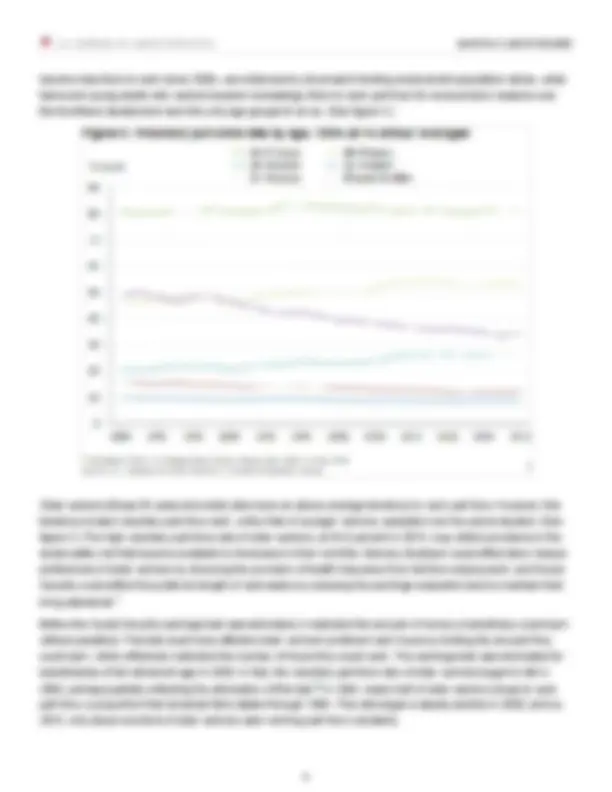


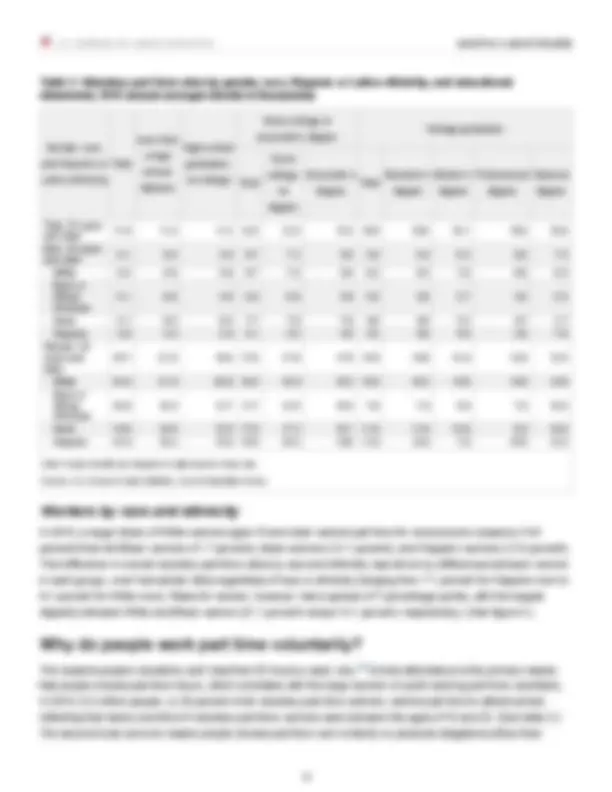
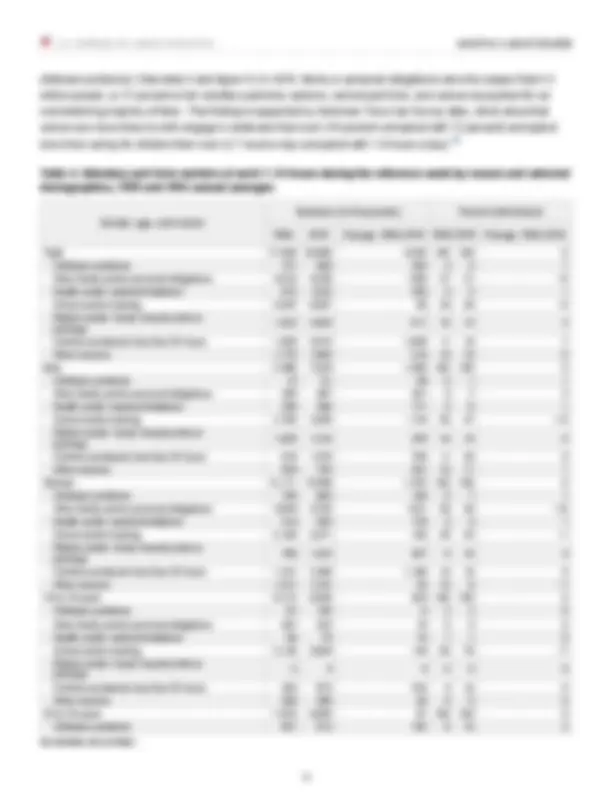

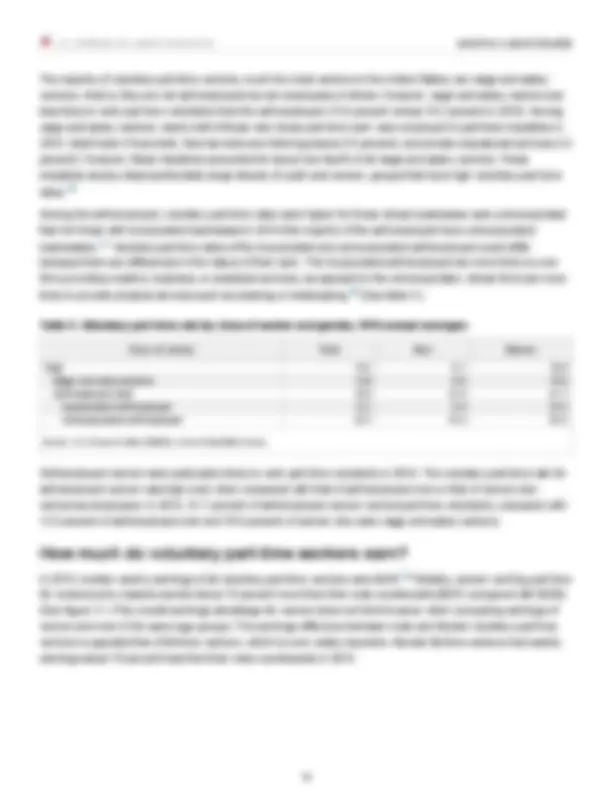
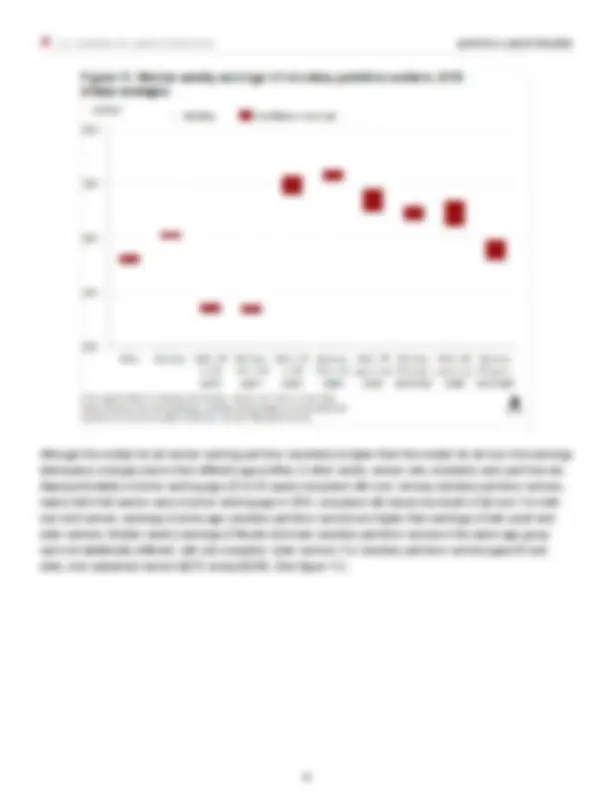
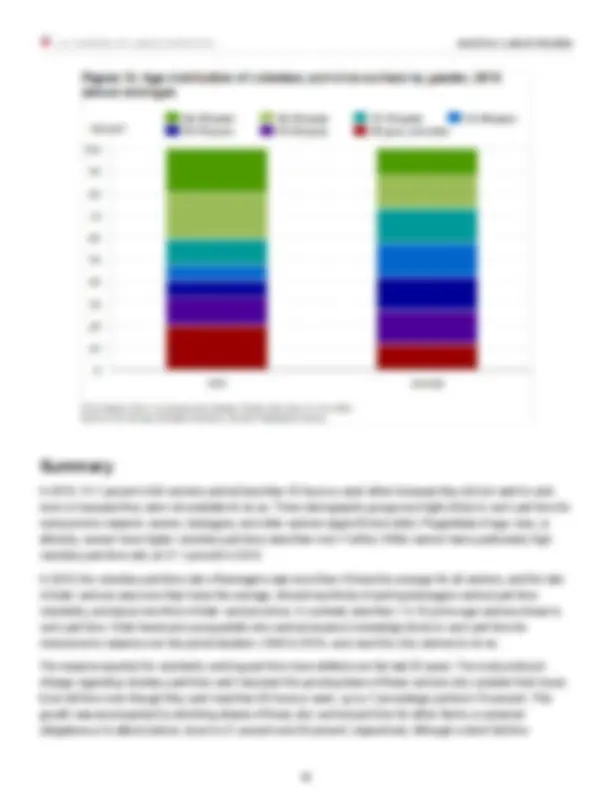

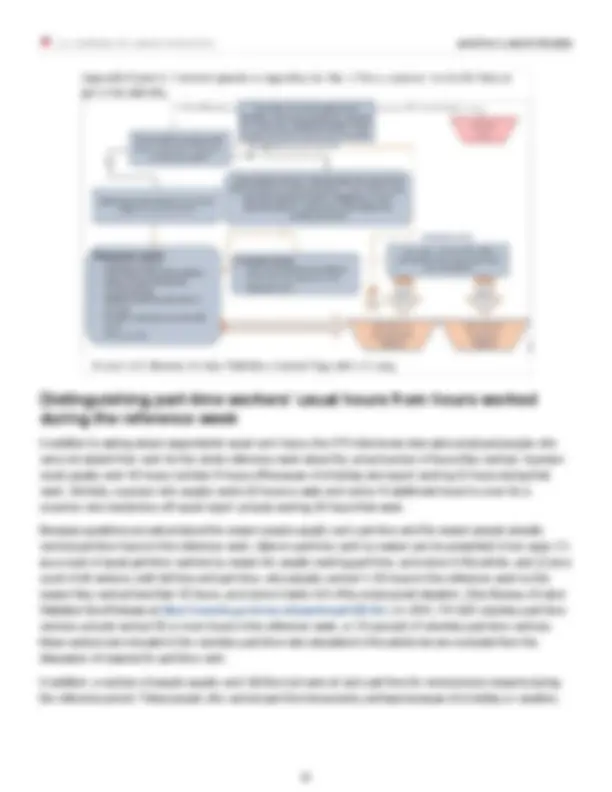

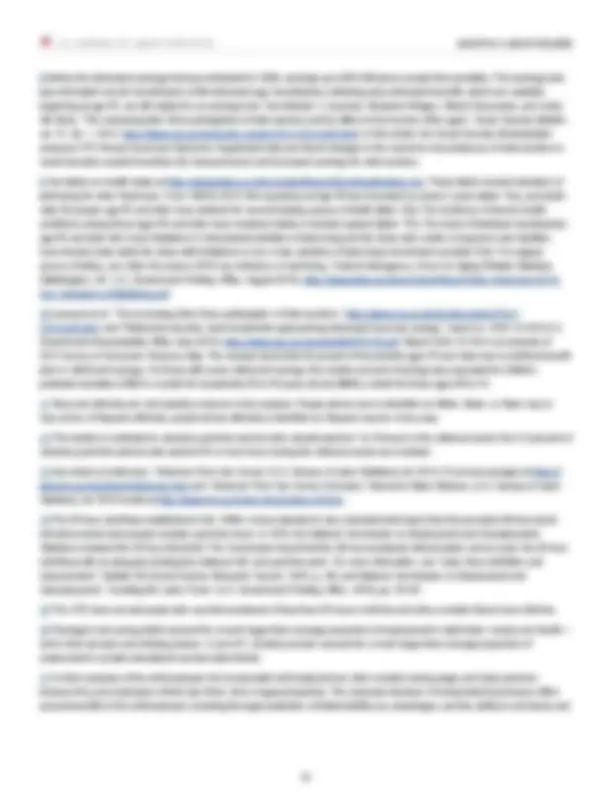



Study with the several resources on Docsity

Earn points by helping other students or get them with a premium plan


Prepare for your exams
Study with the several resources on Docsity

Earn points to download
Earn points by helping other students or get them with a premium plan
Community
Ask the community for help and clear up your study doubts
Discover the best universities in your country according to Docsity users
Free resources
Download our free guides on studying techniques, anxiety management strategies, and thesis advice from Docsity tutors
This article explores the demographic groups and reasons behind people working part-time hours in the US. In 2016, 27.7 million people worked part-time, with 3.1% being involuntary part-time workers. The voluntary part-time rate remained steady, with women, teenagers, older workers, and self-employed individuals being the most likely to work part-time voluntarily. Reasons for part-time work include economic and noneconomic factors, such as family obligations, health issues, and retirement.
Typology: Study notes
1 / 25

This page cannot be seen from the preview
Don't miss anything!


















Often, discussions about part-time work focus on people
who want to work full time. This article, however, examines
the people who want to work part time among different
demographic groups and their reasons for working part
time.
In 2016, 27.7 million people usually worked part time (that
is, they usually worked less than 35 hours a week).^1 Part-
time workers are categorized by the reason they work part
time—economic or noneconomic.^2 Most analysis of part-
time work concentrates on people working part time for
economic reasons—often called “involuntary part-time
workers”—because of the cyclical nature of this type of
part-time work and the associated policy implications.
Involuntary part-time workers want full-time work but work
part time because of slack business conditions or because
they only found part-time jobs.^3 Less than one-fifth of part-
time workers (4.7 million) belonged in this category of part-
time employment in 2016, or about 3.1 percent of all
workers.
In contrast, slightly more than three-quarters of part-time
workers (21.4 million) worked part time for noneconomic
reasons in 2016, accounting for about 14.1 percent of total employment. These workers are often called
“voluntary” part-time workers because they either do not want to work 35 or more hours a week or are not
available to do so. In the last 20 years, the share of employed people who worked part time voluntarily held fairly
steady, trending down only gradually. Despite this overall stability, noteworthy differences can be observed below
the surface in the likelihood of voluntary part-time work among different groups and in the specific reasons people
work part time. This article will focus on voluntary part-time workers. (See figure 1.)
March 2018
Data and concepts
The following analysis is based on data from the Current Population Survey (CPS), a monthly sample survey of
approximately 60,000 households nationwide. The CPS defines “part-time workers” as those who usually work 0 to
34 hours a week.^4 The CPS interviewer asks a series of questions to determine people’s work hours. If people
report that they usually work less than 35 hours, the interviewer asks their reasons for working part time. The
survey interviewer also asks about people’s actual hours during the survey reference week, which can differ from
their usual hours because they worked more or fewer hours than usual during that specific week.^5 (See appendix.)
The responses to these questions are used to classify part-time workers as either part time for economic reasons
(involuntary) or part time for noneconomic reasons (voluntary). The distinguishing factor is that people who work
part time for noneconomic reasons either do not want or are not available to work 35 or more hours a week.
People work part time for a variety of noneconomic reasons, including childcare problems, health problems, or a
full-time workweek that is less than 35 hours. (See table 1 for a full list of noneconomic reasons for part-time work.)
Noneconomic reason Description
Childcare problems Work less than 35 hours for reasons related specifically to affordable, available, or adequatechildcare
Table 1. Noneconomic (voluntary) reasons for working part time
See footnotes at end of table.
*In this article, these part-time concepts refer specifically to a person’s usual work hours, but they are more often presented on the basis of the number of hours a person actually worked during the survey reference week regardless of his or her usual full- or part-time status.
A key metric used for comparisons in this article is the voluntary part-time rate, or the percentage of all employed
people who work part time voluntarily. In this analysis, the term “part time” includes workers who usually work part-
time hours, regardless of whether their actual hours at work during the reference week were full or part time.
However, part-time workers who did not work during the reference week are not included in this rate because they
are not asked about the reason they work part time and therefore cannot be classified as either voluntary or
involuntary.
Who works part time voluntarily?
Women, teenagers, and older workers
Historically, women have been more likely than men to work part time voluntarily. However, the voluntary part-time
rate for women trended down modestly from 1994 through 2013, driving the trend in the overall voluntary part-time
rate. In 2016, about 1 in 5 working women worked part time for noneconomic reasons. The proportion of employed
men voluntarily working part time varied little over much of the last two decades. However, their voluntary part-time
rate has trended upward slightly in recent years, reaching nearly 1 in 10 in 2016. Voluntary part-time rates for
women were higher than those for men regardless of age, race, or ethnicity. (See table 2 and figures 2–4.)
Source: U.S. Bureau of Labor Statistics, Current Population Survey.
By age, teenagers and older workers are more likely to choose part-time work than people of prime working age
(25 to 54 years old). Employed teenagers have the highest voluntary part-time rates of any age group. Given
school schedules, some states’ restrictions on hours for those younger than age 18, and shifting labor−leisure
preferences of young people,^6 it is no surprise many employed 16- to 17-year-olds work part time. For instance, in
2016, about 4 out of 5 employed 16- to 17-year-olds worked part time voluntarily. Older teenagers, ages 18 and
19, also were inclined to work part time—slightly more than half of those employed worked part time voluntarily in
2016, a modest increase from the rate in 1994. Although teenagers and young adults (20 to 24 years old) have
Age Total Men Women
Total, 16 years and older 21,421 7,305 14, 16 to 19 years 3,142 1,448 1, 20 to 24 years 3,654 1,521 2, 25 to 34 years 3,067 885 2, 35 to 44 years 2,681 510 2, 45 to 54 years 2,679 536 2, 55 to 64 years 3,113 948 2, 65 years and older 3,086 1,457 1,
Table 2. Voluntary part-time workers by age and gender, 2016 annual averages (levels in thousands)
become less likely to work since 2000—as evidenced by downward trending employment-population ratios—older
teens and young adults who worked became increasingly likely to work part time for noneconomic reasons over
the timeframe studied and were the only age groups to do so. (See figure 5.)
Older workers (those 65 years and older) also have an above-average tendency to work part time. However, this
tendency toward voluntary part-time work, unlike that of younger workers, subsided over the period studied. (See
figure 5.) The high voluntary part-time rate of older workers, at 34.6 percent in 2016, may reflect provisions in the
social safety net that become available to Americans in their mid-60s. Namely, Medicare could affect labor−leisure
preferences of older workers by divorcing the provision of health insurance from full-time employment, and Social
Security could affect the preferred length of workweeks by reducing the earnings recipients need to maintain their
living standards.^7
Before the Social Security earnings test was eliminated, it restricted the amount of money a beneficiary could earn
without penalties. This test could have affected older workers’ preferred work hours by limiting the amount they
could earn, which effectively restricted the number of hours they could work. The earnings test was eliminated for
beneficiaries of full retirement age in 2000. In fact, the voluntary part-time rate of older workers began to fall in
2000, perhaps partially reflecting the elimination of this test.^8 In 1994, nearly half of older workers chose to work
part time, a proportion that remained fairly stable through 1999. This rate began a steady decline in 2000, and by
2016, only about one-third of older workers were working part time voluntarily.
Among prime-age workers, married women were the most likely to work part time for noneconomic reasons, and
married men were the least likely to do so (16.7 percent versus 2.3 percent). Among women, those who were
divorced had the lowest voluntary part-time rate (10.3 percent). Among men, the highest rate (widowed men, at 7.
percent) was still lower than the lowest rate for women. (See figure 7.)
Among women, married White women were the most likely to choose part-time work in 2016, at 17.8 percent.^11 In
fact, married women had the highest rates within each race or ethnicity group except for among Black women.
Voluntary part-time rates for married Black women were considerably lower than rates for married women in all
other groups. Voluntary part-time rates for men differed little by race and ethnicity across most marital statuses.
(See figure 8.)
Note: People identified as Hispanic or Latino may be of any race.
Source: U.S. Bureau of Labor Statistics, Current Population Survey.
Workers by race and ethnicity
In 2016, a larger share of White workers ages 16 and older worked part time for noneconomic reasons (14.
percent) than did Black workers (11.7 percent), Asian workers (12.1 percent), and Hispanic workers (12.4 percent).
This difference in overall voluntary part-time rates by race and ethnicity was driven by differences between women
in each group—men had similar rates regardless of race or ethnicity (ranging from 7.1 percent for Hispanic men to
9.1 percent for White men). Rates for women, however, had a spread of 7 percentage points, with the largest
disparity between White and Black women (21.1 percent versus 14.1 percent, respectively). (See figure 4.)
Why do people work part time voluntarily?
The reasons people voluntarily work less than 35 hours a week vary.^12 School attendance is the primary reason
that people choose part-time hours, which correlates with the large number of youth working part time voluntarily.
In 2016, 6.0 million people, or 29 percent of all voluntary part-time workers, worked part time to attend school,
reflecting that nearly one-third of voluntary part-time workers were between the ages of 16 and 24. (See table 2.)
The second most common reason people choose part-time work is family or personal obligations (other than
Gender, race, and Hispanic or Latino ethnicity
Total
Less than a high school diploma
High school graduates, no college
Some college or associate’s degree
College graduates
Total
Some college, no degree
Associate’s degree
Total
Bachelor’s degree
Master’s degree
Professional degree
Doctoral degree
Total, 25 years and older 11.0^ 11.3^ 11.2^ 12.3^ 12.3^ 12.3^ 10.0^ 10.0^ 10.1^ 10.0^ 10. Men, 25 years and older 6.1^ 6.0^ 5.9^ 6.7^ 7.2^ 5.9^ 5.9^ 5.4^ 6.3^ 8.0^ 7. White 6.2 5.6 5.8 6.7 7.3 5.9 6.2 5.5 7.0 8.8 8. Black or African American
Asian 5.1 6.5 6.5 7.7 7.6 7.9 4.0 4.6 3.2 4.7 2. Hispanic 3.9 3.3 3.4 5.1 5.5 4.5 4.2 4.0 4.0 2.9 7. Women, 25 years and older
White 18.0 21.8 20.0 19.3 19.4 19.2 15.6 16.2 14.6 14.5 14. Black or African American
Asian 14.0 19.6 15.9 17.6 17.2 18.1 11.9 11.9 13.0 8.3 10. Hispanic 15.3 19.2 15.9 15.6 16.2 14.8 11.0 12.0 7.6 16.5 13.
Table 3. Voluntary part-time rates by gender, race, Hispanic or Latino ethnicity, and educational
attainment, 2016 annual averages (levels in thousands)
childcare problems). (See table 4 and figure 9.) In 2016, family or personal obligations were the reason that 4.
million people, or 21 percent of all voluntary part-time workers, worked part time, and women accounted for an
overwhelming majority of them. This finding is supported by American Time Use Survey data, which show that
women are more likely to both engage in eldercare than men (18 percent compared with 15 percent) and spend
more time caring for children than men (2.1 hours a day compared with 1.6 hours a day).^13
Gender, age, and reason
Numbers (in thousands) Percent distribution
1994 2016 Change, 1994–2016 1994 2016 Change, 1994–
Total 17,638 20,680 3,042 100 100 0 Childcare problems 751 956 205 4 5 1 Other family and/or personal obligations 4,810 4,250 −560 27 21 − Health and/or medical limitations 673 1,023 350 4 5 1 School and/or training 5,947 6,007 60 34 29 − Retired and/or Social Security limit on earnings
Full-time workweek less than 35 hours 1,859 3,815 1,956 11 18 7 Other reasons 1,776 1,995 219 10 10 0 Men 5,468 7,034 1,566 100 100 0 Childcare problems 15 61 46 0 1 1 Other family and/or personal obligations 206 467 261 4 7 3 Health and/or medical limitations 259 430 171 5 6 1 School and/or training 2,760 2,636 −124 50 37 − Retired and/or Social Security limit on earnings 1,055^ 1,310^255 19 19 Full-time workweek less than 35 hours 618 1,376 758 11 20 9 Other reasons 554 755 201 10 11 1 Women 12,171 13,646 1,475 100 100 0 Childcare problems 736 895 159 6 7 1 Other family and/or personal obligations 4,604 3,783 −821 38 28 − Health and/or medical limitations 414 593 179 3 4 1 School and/or training 3,188 3,371 183 26 25 − Retired and/or Social Security limit on earnings 766 1,323^557 6 10 Full-time workweek less than 35 hours 1,241 2,440 1,199 10 18 8 Other reasons 1,221 1,241 20 10 9 − 16 to 24 years 6,212 6,636 424 100 100 0 Childcare problems 97 105 8 2 2 0 Other family and/or personal obligations 307 323 16 5 5 0 Health and/or medical limitations 59 78 19 1 1 0 School and/or training 5,128 5,064 −64 83 76 − Retired and/or Social Security limit on earnings 0 4 4 0 0 0 Full-time workweek less than 35 hours 263 673 410 4 10 6 Other reasons 358 388 30 6 6 0 25 to 54 years 7,978 8,065 87 100 100 0 Childcare problems 651 813 162 8 10 2
Table 4. Voluntary part-time workers at work 1–34 hours during the reference week by reason and selected
demographics, 1994 and 2016 annual averages
See footnotes at end of table.
A full-time workweek of less than 35 hours, which has become more common over time, is the third most common
reason for voluntary part-time work.^14 The number of voluntary part-time workers who maintained that their hours
were full time more than doubled since 1994, reaching 3.8 million in 2016. These workers accounted for about 18
percent of all voluntary part-time workers in 2016, up from 11 percent in 1994.
The growth in the number and share of overall voluntary part-time workers who work short full-time workweeks
was evident across all age groups and both genders. Furthermore, this growth was at the expense of the most
common reason for each group. Since 1994, school attendance has been the most common reason men had for
voluntary part-time work. However, the share of men who worked part time for this reason shrank from about one-
half in 1994 to just over one-third in 2016, and the share of men working short full-time workweeks nearly doubled
to 20 percent in 2016. Similarly, family or personal obligations have been the most common reason women worked
part-time hours since 1994. However, the share of women choosing part-time hours for this reason shrank by 10
percentage points to 28 percent in 2016, while the share working short full-time weeks grew by 8 percentage
points, to 18 percent. Likewise, in 2016, smaller shares of teenagers and young adults worked part time to attend
school than those who did so in 1994, a smaller share of prime-age workers worked part time because of family
obligations, and smaller shares of workers ages 55 and older worked part time because they were retired.
Meanwhile, the share of each of these groups that had short full-time workweeks grew—either because fewer
workers were reporting the most common reason for their group or because the growth in the number reporting
short full-time workweeks was larger than overall growth, or both. (See figure 10 and table 4.)
This phenomenon has several plausible explanations. The rise of the short full-time workweek could be a
byproduct of the decades-long shift away from industries that have a traditional 40-hour workweek toward those
with shorter average weeks, such as retail or leisure and hospitality. It could also possibly reflect employers
offering work schedules that more closely match their workers’ preferences for shorter work hours, productivity
gains reducing the number of labor hours that employers need, or even a shift in workers’ perceptions of a full-time
schedule. The dynamics behind these reported short “full-time” workweeks are not readily evident because of
limitations in the data.^15 Presumably, different situations could lead people to describe their work hours as full time,
even though they do not meet the 35-hour threshold that has been used for statistical purposes since the 1940s.
All that these data can reveal is that a growing number of people consider their hours to be full time even though
they meet the statistical definition of a part-time worker.
The remaining reasons people voluntarily work part time combined—childcare problems, health or medical
limitations, and other reasons—apply to about 20 percent of all voluntary part-time workers. Notably, among all
voluntary part-time workers, only about 5 percent worked part time because they could not find adequate or
affordable childcare in 2016, relatively unchanged since 1994. As expected, women were more likely to work part
time for this reason than were men (7 percent versus 1 percent in 2016). Nevertheless, relative to other reason
categories, few women chose their work hours for this reason.
Where do voluntary part-time workers work?
Although the median for all women working part time voluntarily is higher than the median for all men, this earnings
discrepancy is largely due to their different age profiles. In other words, women who voluntarily work part time are
disproportionately of prime working age (25 to 54 years) compared with men. Among voluntary part-time workers,
nearly half of all women were of prime working age in 2016, compared with about one-fourth of all men. For both
men and women, earnings of prime-age voluntary part-time workers are higher than earnings of both youth and
older workers. Median weekly earnings of female and male voluntary part-time workers in the same age group
were not statistically different, with one exception: older workers. For voluntary part-time workers ages 65 and
older, men outearned women ($272 versus $238). (See figure 12.)
Summary
In 2016, 14.1 percent of all workers worked less than 35 hours a week either because they did not want to work
more or because they were not available to do so. Three demographic groups are highly likely to work part time for
noneconomic reasons: women, teenagers, and older workers (ages 65 and older). Regardless of age, race, or
ethnicity, women have higher voluntary part-time rates than men. Further, White women had a particularly high
voluntary part-time rate, at 21.1 percent in 2016.
In 2016, the voluntary part-time rate of teenagers was more than 4 times the average for all workers, and the rate
of older workers was more than twice the average. Almost two-thirds of working teenagers worked part time
voluntarily, and about one-third of older workers did so. In contrast, less than 1 in 10 prime-age workers chose to
work part time. Older teens and young adults who worked became increasingly likely to work part time for
noneconomic reasons over the period studied—1994 to 2016—and were the only workers to do so.
The reasons reported for voluntarily working part time have shifted over the last 20 years. The most profound
change regarding voluntary part-time work has been the growing share of these workers who consider their hours
to be full time even though they work less than 35 hours a week, up by 7 percentage points to 18 percent. This
growth was accompanied by shrinking shares of those who worked part time for either family or personal
obligations or to attend school, down to 21 percent and 29 percent, respectively. Although a short full-time